Location-specific and season-smart fertilizer recommendations for smallholder farmers are a prominent feature of innovative decision support tools (DSTs) currently being developed in the ICT4Ag space. In Ethiopia, a coalition of the CGIAR Excellence in Agronomy Initiative (EiA), GIZ-Ethiopia of Supporting Soil Health Initiatives (SSHI) project, the Coalition of the Willing (CoW), and Digital Green have developed fertilizer recommendationsspecific to soil types, topographic features, and climate zones which could significantly improve the productivity in the wheat growing areas of Ethiopia and thus save money and boost income for farmers who currently rely on government blanket recommendations.
The advisory messages are being distributed through different channels, starting with community video screenings in partnership with Digital Green, on-field piloting and potentially via Interactive Voice Response (IVR) technology.
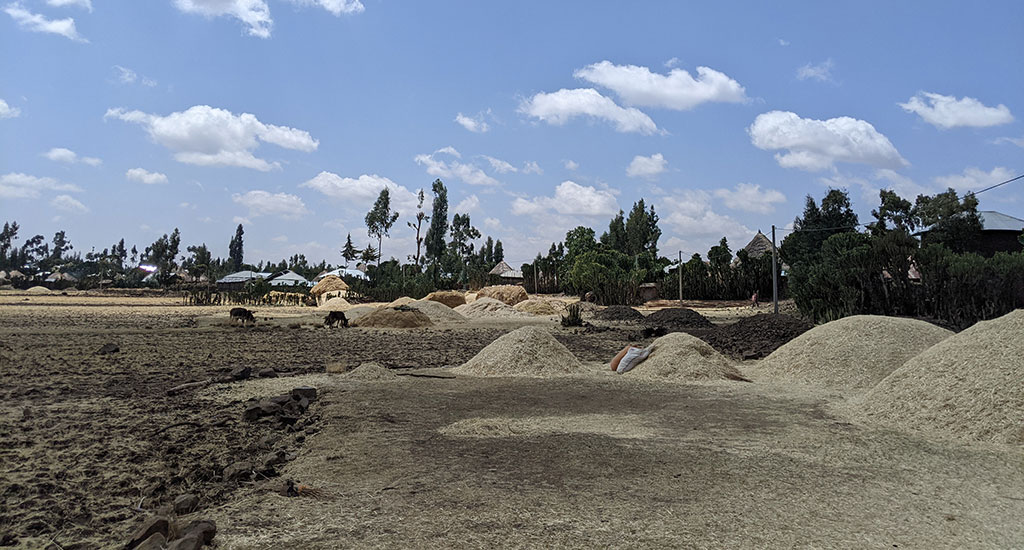
Harvest on the fields in Debre Brehan
The problem
After deploying the agro-advisory services in the highlands of Ethiopia, the initial adoption of the fertilizer advisory messages delivered currently via community videos was good, but concerns were raised on sustainability without regular, physical follow ups from extension agents., and whether the uptake could be further improved. Following this, the team realized the need for more user insights to help address the farmers’ specific needs.
A common problem in the development of digital innovations, the design is often driven by technological possibilities rather than identified needs and media habits of the targeted users. In order to render innovation design more sustainable, the EiA initiative is realizing training and capacity building around the value of Human Centered Design (HCD) and User Research for digital agricultural innovations.
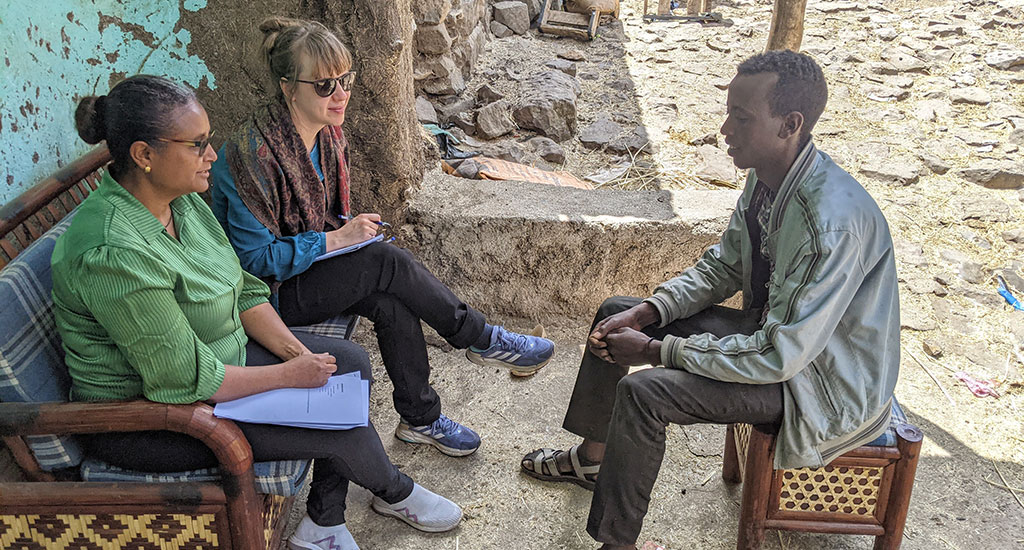
User interviews in Debre Brehan
Describing the value of this approach, Anna Muller, scientist with the Alliance of Bioversity and CIAT said, “We want to reverse how we currently develop innovations, where we come as researchers and develop a tool that we think could be the best solution and kind of impose it, or deploy it. So, what we want to achieve with our work and research is that we engage with the farmers or users, understand their needs and acknowledge that they make the best decisions for their environment. This entails acknowledging ambiguity, learning from failure, and building on many loops of duplication and learning. In a nutshell, HCD allows us to be familiar with users’ needs and build better solutions for them.”
As part of this learning approach, EiA organized a User Research Discovery Week in Addis Ababa, with the help of the User Research expert Charlotte Schumann. During this week, the Ethiopia Use Case team and partners – Digital Green, Ministry of Agriculture, and GIZ – were exposed to HCD and User Research methods and concepts in theory and practice, and some of the initial questions of the collaboratively designed agenda circled around alternative approaches to user segmentation.
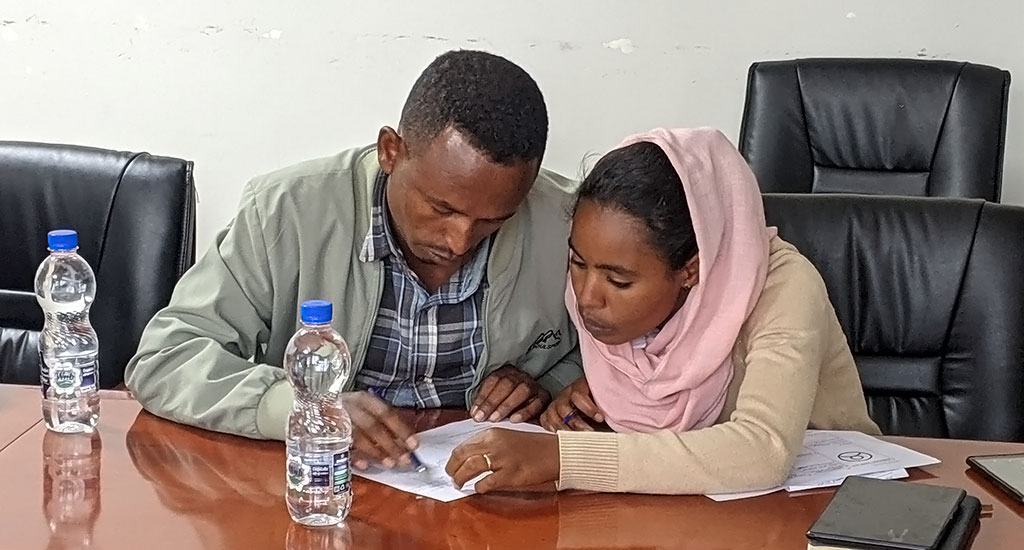
Building User Personas with the extension agents
Two questions were at the heart of this training: First, the team wanted to understand their target group needs and started diving into the construction of User Personas. A User Persona is an idealized user profile that represents the needs and goals, attitudes and behavior patterns of users rather than demographic identifiers like age, gender, or household size. Built on exploratory interviews, User Personas can help design teams at any stage in the innovation development cycle to empathize with their users’ situation as well as prioritize features that are fulfilling actual needs based on data.
In the recently harvested wheat fields of Debre Birhan, North Shoa zone of Amhara region, the team met farmers in their houses and gathered data on their perspective on the issue of fertilization. In order to design User Personas, the interviews focused on areas like; what are the steps to take and which barriers do farmers encounter? What is their perception of the existing communication channels regarding the topic? What are they striving for when fertilizing and what are their experiences so far?
In a few exploratory interviews, the team discovered new perspectives on the topic of fertilization through the eyes of smallholder farmers. For instance, access is regulated via the state in Ethiopia, and many farmers are not able to access the amount of fertilizer they may require.
Secondly, prices have gone up (among the highest in 2021/2022 season) and farmers have to take micro-credits to be able to pay for fertilizer at a time their cash availability is low, during planting season. In this context, farmers were also highly interested in learning more about how to make their own organic input and usage of these alternatives. All these topics matter for farmers and constitute the real world context in which they receive the location-specific recommendations built by the team.
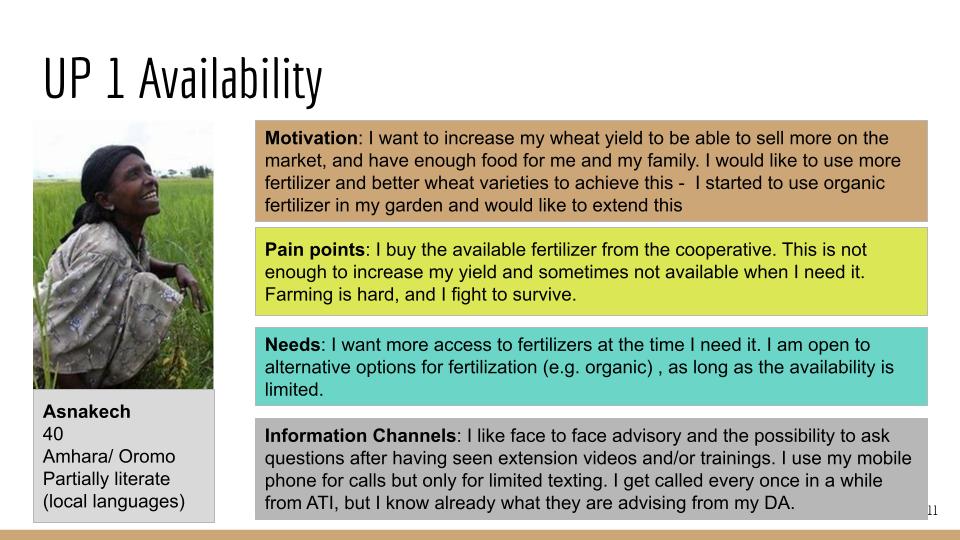
Preliminary User Persona
Adding to these qualitative insights, the team had a joint brainstorming session with extension agents to sort and identify insights into categories around the topic of fertilization. This way, several preliminary personas were drafted around issues concerning fertilization.
Following the field experience, the team used the Rapid Gender Inclusivity Assessment Tool (RIA) to analyze difficulties women would face if the site-specific fertilizer recommendations are shared via Interactive Voice Recognition technology (IVR).
RIA is a version of the design method User Journey adapted to the stakeholders and context of CGIAR projects; a tool for the step-by-step analysis of the experience a user has or would have with a product or technology, in this case accessing pre-recorded messages via their phones.
By going through the experience from the perspective of a female user, the team were able to learn about the experience of a first-time user and discovered gaps in the female experience. This relates to for instance, how women could hear about these services, or the details of phone use in rural areas – connection breakdown, charging issues, no phone book or internet to look up the phone numbers; etc. After having mapped these issues, the team brainstormed on potential solutions to explore – e.g. printing posters with the numbers to dial or promoting the use of solar chargers in the villages.
Commenting on the in-person training during the Discovery Week, Wuletawu Abera, data scientist, stated his enthusiasm for problem definition with qualitative, bottom up methods, “One of the things that I would love to implement in the future is to design our technologies in the way that they can accommodate the interest of smallholder farmers. Not just in a top-down approach, but to address the interest, the motivations and frustration of the farmers. The idea is that we generate a lot of innovations, with the thinking that we understand the problem of the farmer but in fact, at the core we still don’t understand how to apply it on the ground. So, these methods help us to articulate, to understand the pain point of the challenge that the farmers face.”
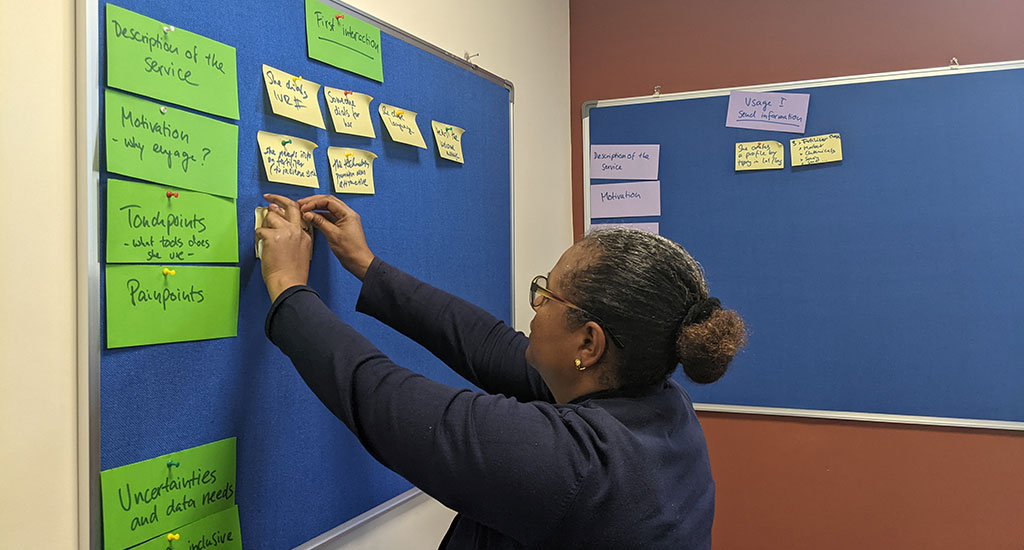
Applying the RIA with partners
As next steps after the Discovery Week, the team will develop a User Research plan for more in-depth application of the User Persona methodology.
Principal scientist Lulseged Desta is determined to increasingly use Human Centered Design methods to address real needs and limitations of the farmers in Ethiopia.
“I was not really sure whether we can represent the situation of Ethiopian farmers by interviewing 6 to 7 farmers. I realized after discussing with these farmers and extension workers that most of the conditions can be represented based on this small sample. It was a great exercise to discuss with extension on how to characterize farmers’ fertilization practices. After this training, the whole team realized how essential it is to start to apply Human Centered Design methods to really understand what the farmers need, what their priorities and constraints are, and what the surrounding limitations and enabling environments are”.
Disclaimer:
This work has been made possible by a cooperation between the CGIAR Excellence in Agronomy Initiative (EiA) as well as by the Digital Innovation Initiative (DI/DX). The CGIAR Excellence in Agronomy (EiA) Initiative, was launched to deliver agronomic gain through an increase in productivity and quality per unit of input, resource use efficiency – Nutrients, Labour, Water – soil health, and climate adaptation, for millions of smallholder farming households in prioritized farming systems by 2030, with an emphasis on women and young farmers, showing a measurable impact on food and nutrition security, income, resource use, soil health, climate resilience and climate change mitigation. The CGIAR Digital Innovation (DI/DX) Initiative aims to develop and support digital innovations to stimulate the inclusive, sustainable transformation of food, land and water systems in the areas of investments that policymakers could make to close the digital divide, information delivery systems that allow more people to take action against predicted risks, and ways for partner organizations and marginalized communities to enhance digital capabilities, access resources and opportunities.
For more information, contact:
Anna Muller (DI/DX)
A.Muller@cgiar.org
Charlotte Schumann (HCD/User Research)
charlotte.schumann@fu-berlin.de
Lulseged Desta (EiA)
LT.Desta@cgiar.org

No Comments